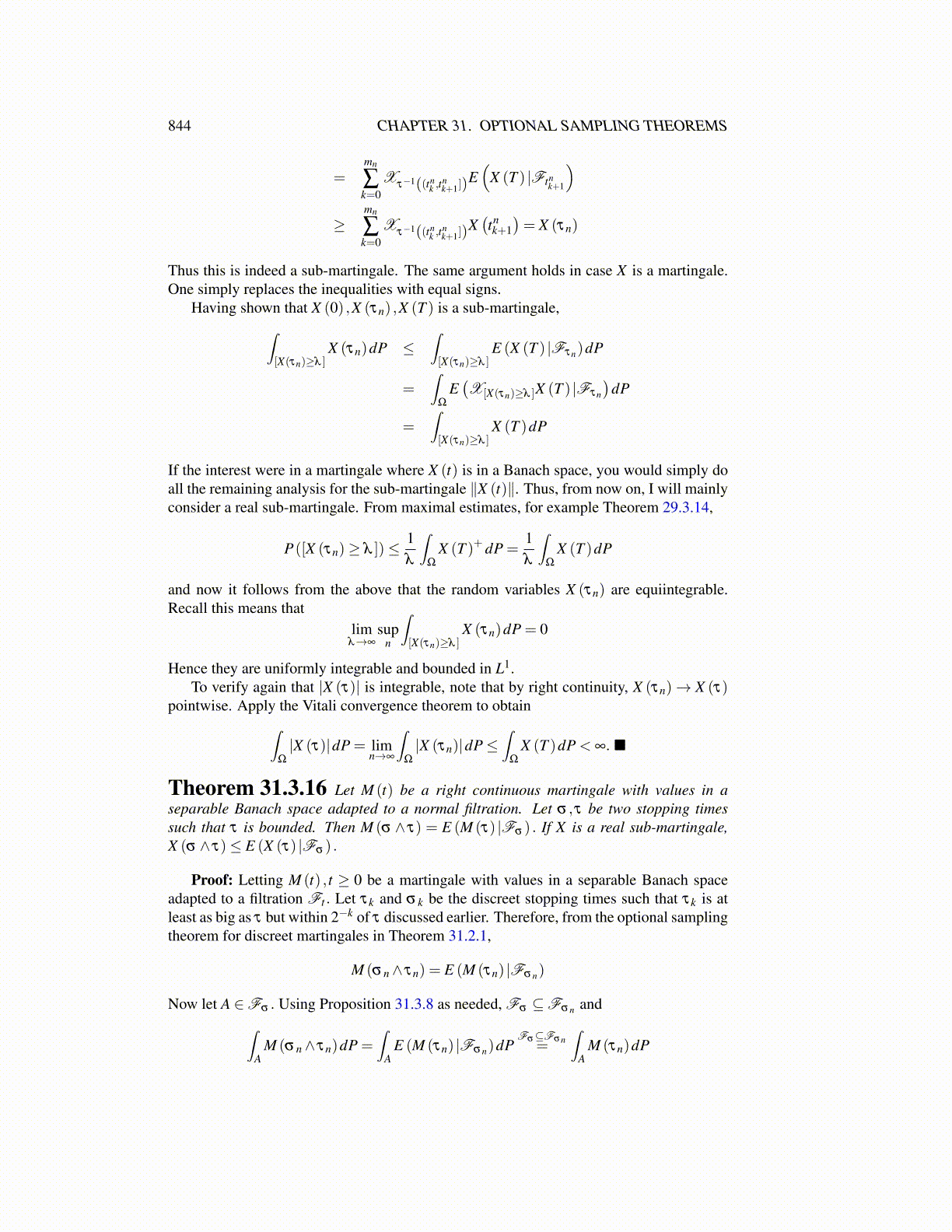
844 CHAPTER 31. OPTIONAL SAMPLING THEOREMS
=mn
∑k=0
Xτ−1((tn
k ,tnk+1])
E(
X (T ) |Ftnk+1
)≥
mn
∑k=0
Xτ−1((tn
k ,tnk+1])
X(tnk+1)= X (τn)
Thus this is indeed a sub-martingale. The same argument holds in case X is a martingale.One simply replaces the inequalities with equal signs.
Having shown that X (0) ,X (τn) ,X (T ) is a sub-martingale,∫[X(τn)≥λ ]
X (τn)dP ≤∫[X(τn)≥λ ]
E (X (T ) |Fτn)dP
=∫
Ω
E(X[X(τn)≥λ ]X (T ) |Fτn
)dP
=∫[X(τn)≥λ ]
X (T )dP
If the interest were in a martingale where X (t) is in a Banach space, you would simply doall the remaining analysis for the sub-martingale ∥X (t)∥. Thus, from now on, I will mainlyconsider a real sub-martingale. From maximal estimates, for example Theorem 29.3.14,
P([X (τn)≥ λ ])≤ 1λ
∫Ω
X (T )+ dP =1λ
∫Ω
X (T )dP
and now it follows from the above that the random variables X (τn) are equiintegrable.Recall this means that
limλ→∞
supn
∫[X(τn)≥λ ]
X (τn)dP = 0
Hence they are uniformly integrable and bounded in L1.To verify again that |X (τ)| is integrable, note that by right continuity, X (τn)→ X (τ)
pointwise. Apply the Vitali convergence theorem to obtain∫Ω
|X (τ)|dP = limn→∞
∫Ω
|X (τn)|dP≤∫
Ω
X (T )dP < ∞. ■
Theorem 31.3.16 Let M (t) be a right continuous martingale with values in aseparable Banach space adapted to a normal filtration. Let σ ,τ be two stopping timessuch that τ is bounded. Then M (σ ∧ τ) = E (M (τ) |Fσ ) . If X is a real sub-martingale,X (σ ∧ τ)≤ E (X (τ) |Fσ ) .
Proof: Letting M (t) , t ≥ 0 be a martingale with values in a separable Banach spaceadapted to a filtration Ft . Let τk and σ k be the discreet stopping times such that τk is atleast as big as τ but within 2−k of τ discussed earlier. Therefore, from the optional samplingtheorem for discreet martingales in Theorem 31.2.1,
M (σn∧ τn) = E (M (τn) |Fσn)
Now let A ∈Fσ . Using Proposition 31.3.8 as needed, Fσ ⊆Fσn and∫A
M (σn∧ τn)dP =∫
AE (M (τn) |Fσn)dP
Fσ⊆Fσn=∫
AM (τn)dP